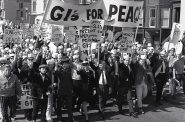Milwaukee Art Museum presents diverse work by 30 (African) Americans
"30 Americans" is a powerful survey of contemporary art by prominent African American artists, whose works cover a variety of interests, racial and otherwise.

Glenn Ligon, America, 2008. Neon sign and paint. Artists pictured left to right: Rashid Johnson, Nick Cave, Kalup Linzy, Jeff Sonhouse, Lorna Simpson, Carrie Mae Weems, Barkley L. Hendricks, Hank Willis Thomas (front row), Xaviera Simmons, Purvis Young, John Bankston, Nina Chanel Abney, Henry Taylor, Mickalene Thomas (front row), Kerry James Marshall and Shinique Smith. Photo Credit: Kwaku Alston.
This summer the Milwaukee Art Museum hosts 30 Americans, an exhibition of about 80 works drawn from the Rubell Family Collection of Miami, Florida. An essay by the Rubell family in the catalog succinctly describes the development of the title:
This important distinction and is foundational for this exhibition. Though race is a unifying factor, the works on view represent a powerful survey of artists working within a broad territory of often socially charged subjects. African American experience might deeply influence the work, but it is ultimately much more than just a black thing.
Generations of influence come together, from artists whose careers accelerated in the postwar period to younger practitioners following in their footsteps. A photograph summarizes this connection, as emerging and established artists stand together in front of an installation by Glenn Ligon. The light sculpture America makes a big statement. It seems clear and straightforward but is enlivened with variation in its structure, the pale light clarified by the dark outlines. It’s a word, a name, but what are its myriad meanings?
Textual statements are prominent in the work of many artists, including Jean-Michel Basquiat. Bird On Money references jazz, and like the deft improvisations and melding of influences found in music, Basquiat synthesizes the aesthetics of graffiti, an intuitive language of glyphs, and the refinement of cultural references to jazz, notably Charlie “Bird” Parker. Simultaneously, the intuitive reflexes of images are melded with undercurrents of learned codes.
Kara Walker’s Camptown Ladies stretches across 40 feet of a gallery wall. Walker’s characteristic silhouettes are like shadows, ethereal but indelible. The figures in black recall stereotypes and moments of imagined or real history that are breathlessly unspeakable and strange, yet remembered in the disembodied space. The paper cutouts are an exhibition copy made after the artist’s original and mounted directly on the wall to exacting specifications. At the end of the exhibition, it will be torn down and ultimately destroyed but will remain in memory and like the past itself.
William Pope.L’s The Great White Way, 22 miles, 9 years,1 street, 2001-2002 is also installed according to the artist’s instructions. The video monitor is close to the ground. In the five-minute video, the artist, dressed in a superhero costume, crawls, shimmies and at times coasts on his back on a skateboard along Broadway in Manhattan, the longest street in the borough. The performance of the work actually took place over the course of nine years as Pope.L traveled the length of Broadway bit by bit. There is a great deal of irony, as the heroic figure struggles through the urban landscape traversed easily by pedestrians. The gravitas and futility in his gesture lends itself to metaphors of downtrodden aspirations.
Kalup Linzy also works in the medium of video, taking familiar tropes and turning them around. In Conversations with de Churen V: As da Art World Might Turn, 2006, the artist conflates the conventions of soap operas with art world angst. The protagonist and supporting characters are played to the hilt and beyond by the artist and others in drag. It’s overt satire, a parade of cliches, though we might stop and ask ourselves why and how these caricatures are so easily recognizable.
30 Americans offers some levity and humor in the exhibition, but some points that will check viewers in their tracks. Gary Simmons’ large-scale installation, Duck, Duck, Noose, comprises a circle of ordinary stools. A white, pointed Ku Klux Klan hoods stands, peak erect, on the seat of each stool. A hangman’s noose is suspended above the center of the circle of stools. The silent scene conjures up shades of horror and the meting out of arbitrary and vindictive death. The legacy of slavery also looms in Leonardo Drew’s Untitled #25,1992, sculpture that is a wall made of stacked bales of cotton. It is on one hand a large, minimalist piece, austere in shape but organic in texture. However, the material it is made of diverts it from purely formal concerns and connects it through sotto voce references to slavery and forced labor in fields of cotton.
Race, history, and social identity are significant themes in 30 Americans, but the scope spans a multiplicity of interests, points of view, and purposes in art. The territory covered may overlap in some places, but the way each artist speaks shifts with the individual, each a measured and distinct response to contemporary as well as historical issues and events. The great diversity in this exhibition comes at no cost in clarity and visual power, which reflect clear, meaningful curation.
30 Americans continues at the Milwaukee Art Museum through September 8. Also on view is Wisconsin 30, an exhibition of 30 African American artists with connections to the Milwaukee area.
Art
-
Winning Artists Works on Display
 May 30th, 2024 by Annie Raab
May 30th, 2024 by Annie Raab
-
5 Huge Rainbow Arcs Coming To Downtown
 Apr 29th, 2024 by Jeramey Jannene
Apr 29th, 2024 by Jeramey Jannene
-
Exhibit Tells Story of Vietnam War Resistors in the Military
 Mar 29th, 2024 by Bill Christofferson
Mar 29th, 2024 by Bill Christofferson
























I’ve seen this exhibit a number of times and attended lectures on it and events related to it, and you do a great job of covering all the cogent points – I urge everyone to see it and realize that the Milwaukee artists are a part of Milwaukee’s history.